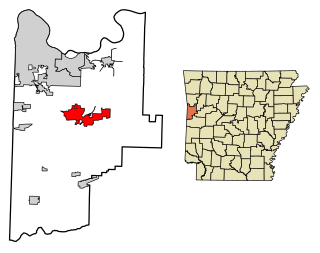
Greenwood is a city in and one of the two county seats of Sebastian County, Arkansas, United States. It is the fifth largest municipality in the Fort Smith, Arkansas-Oklahoma Metropolitan Statistical Area with a population of 8,952 according to the 2010 US Census. According to estimates based on the most recent census, the population of Greenwood in 2018 was 9,397.
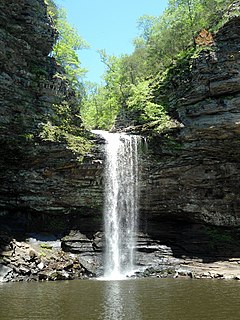
Petit Jean State Park is a 3,471-acre (1,405 ha) park in Conway County, Arkansas managed by the Arkansas Department of Parks and Tourism. It is located atop Petit Jean Mountain adjacent to the Arkansas River in the area between the Ouachita Mountains and Ozark Plateaus.

Blue Spring Heritage Center is a 33-acre (13 ha) privately owned tourist attraction in the Arkansas Heritage Trails System containing native plants and hardwood trees in a setting of woodlands, meadows, and hillsides. It is located at Highway 62 West, five miles (8 km) west of Eureka Springs, Arkansas, and open daily to the public during warmer months for a fee.

Lake Hamilton and Lake Catherine are a pair of man-made lakes around Hot Springs, Arkansas. The two lakes have greatly improved the tourism in Hot Springs. Both Lakes were created by Arkansas Power & Light.
U.S. Route 66 is a former east–west United States Numbered Highway, running from Santa Monica, California to Chicago, Illinois. In Missouri, the highway ran from downtown St. Louis at the Mississippi River to the Kansas state line west of Joplin. The highway was originally Route 14 from St. Louis to Joplin and Route 1F from Joplin to Kansas. It underwent two major realignments and several lesser realignments in the cities of St. Louis, Springfield, and Joplin. Current highways covering several miles of the former highway include Route 100, Route 366, Route 266, Route 96, and Route 66. Interstate 44 (I-44) approximates much of US 66 between St. Louis and Springfield.

The Beard Cabin is a historic cabin listed on the National Register of Historic Places and located in Shawnee, Oklahoma. Built in 1892, it is considered to be the first home built in Shawnee.

The Kimmel Kabins were a tourist camp in Grand Teton National Park. The camp was built in 1937 by J.D. and Lura Kimmel with a rustic lodge and eleven cabins on either side of Cottonwood Creek south of Jenny Lake. The camp is the only remaining example of a motor court-style camp in Grand Teton out of as many as twelve former establishments. The camp eventually featured a store with a post office.

U.S. Route 64 is a U.S. highway running from Teec Nos Pos, Arizona east to Nags Head, North Carolina. In the U.S. state of Arkansas, the route runs 246.35 miles (396.46 km) from the Oklahoma border in Fort Smith east to the Tennessee border in Memphis. The route passes through several cities and towns, including Fort Smith, Clarksville, Russellville, Conway, Searcy, and West Memphis. US 64 runs parallel to Interstate 40 until Conway, when I-40 takes a more southerly route.

The Robert Lee Hardy House is a historic house at 207 South Main Street in Monticello, Arkansas. It was designed for Robert Lee Hardy, a prominent local lawyer, by Knoxville, Tennessee-based architect George Franklin Barber, and built c. 1908–1909, at a time when Monticello was a thriving commercial center. It is unusual for its construction material (brick), and for its elaborate yet restrained Classical and Colonial Revival styling.

The Hardy Downtown Historic District encompasses most of the central business district of the resort community of Hardy, Arkansas. It extends along Main Street, between Church and Cope Streets, and includes a few buildings on adjacent streets. Hardy was founded as a railroad town in the 1880s, but grew by the end of the 19th century into a resort community, serving as commercial center for vacationers from Memphis, Tennessee. Most of the 43 buildings in the district are between one and three stories in height, and of masonry construction. Twenty-four are historically significant, and many of the remaining buildings date to the early 20th century but have been altered in unsympathetic ways. Notable buildings include the Hardy Church of Christ, and the Raymond Daugherty House, one of the community's oldest buildings.
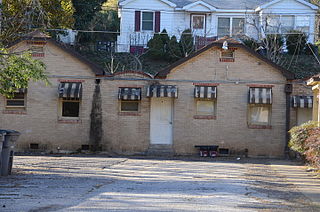
The Bellaire Court Historic District encompasses a former tourist court cottage complex at 637 Park Avenue in Hot Springs, Arkansas. The complex was built in the 1930s, when the advent of vacation travel by automobile rose to prominence. The complex is roughly L-shaped, with a long leg of the L perpendicular to the road, and the short leg at the rear, facing Magnolia Street. It is a single story structure with Craftsman styling, built out of wood and finished in stone veneer and brick trim. At the front of the complex is a manager's house, with cottage-style units lined behind it, each with a space that was originally a garage, but has since been filled in as part of a conversion to full-time residential units.

The Bates Tourist Court is a historic traveler's accommodation on Fair Street in Marshall, Arkansas. The property includes four buildings, three of which are stone-veneered wood-frame cabins. The fourth building, which original housed the office, has been substantially altered since the facility was built about 1935. The property is rare within Searcy County as a surviving example of 1930s road-based tourist architecture.

The Willmering Tourist Cabins Historic District encompasses a historic tourist accommodation on United States Route 65 in central northern Searcy County, Arkansas, just south of the Buffalo National River. Located behind the Silver Hill Float Service on the west side of the highway stand six stone and timber cabins, with large standstone blocks and plank doors on the fronts, and shed roofs obscured by parapets. Built in 1946 by Harry Willmering, these vernacular structures are representative of tourist accommodations built in the period after World War II to cater to the automobile-based vacationing public.
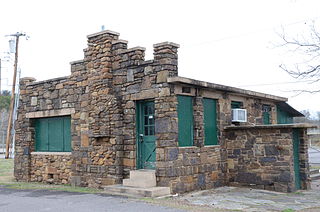
The Merle Whitman Tourist Cabin is a historic traveler's accommodation at 200 North Bell Street in Ozark, Arkansas. It is a distinctively styled vernacular structure, built out of local fieldstone, cut sandstone, and concrete. Built in 1933–34, it is the only known tourist building in Franklin County using this combination of materials. It was used as tourist accommodation until the 1960s, when it was purchased by the United States Army Corps of Engineers as part of land taking for the Jeta Taylor Lock and Dam project. It housed the offices of the local chamber of commerce between 1966 and 1995.

The Lake Catherine State Park CCC Cabins are a collection of four rustic cabins constructed by crews of the Civilian Conservation Corps in what is now Lake Catherine State Park in Hot Spring County, Arkansas. Three of the four cabins were built for use as tourist accommodations and continue to serve in that role, while the fourth, probably built to house administrative functions, is now used in the state park as a "nature cabin", with exhibits on the history and natural environment of the park. Three of the cabins were separately listed on the National Register of Historic Places in 1992; the fourth was listed in 1995.

The George Klein Tourist Court Historic District, also known as Green Elf Court, is a historic tourist accommodation at 501 Morrison Street in Hot Springs, Arkansas. Now an apartment complex, it consists of seven single-story cabins, an elaborate American Craftsman style manager's house, and an octagonal central residence unit with a cantilevered second floor and a bellcast roof. The complex was built about 1940, is one of the city's finest example of a Craftsman style tourist court, a popular form of traveler accommodation prior to World War II.

The Parkway Courts Historic District encompasses a historic tourist accommodation at 815 Park Avenue in Hot Springs, Arkansas. It is a U-shaped tourist court, with 48 units and a building housing an office and manager's residence. The units come in three styles, some with larger sleeping and living spaces, and some with kitchenettes. Each unit is highlighted architecturally by a steeply pitched gable over the entrance. The buildings are brick. The units were built in 1943, and the manager's residence/office in 1950, after the original burned down. It is one of the city's oldest surviving tourist courts.
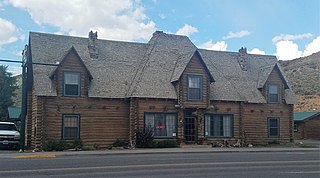
The Twin Pines Lodge and Cabin Camp, also known as the Twin Pines Motel and Frontier Court, is a tourist camp in Dubois, Wyoming on the way to Yellowstone National Park on U.S. Route 287. The camp was established in 1929 by Dubois businessman Oliver Ernest Stringer who designed the camp and assisted in its construction. Stringer had previously been involved in the construction of the Brooks Lake Lodge, where he built furniture.

The King Tower Historic District, also known as The King Tower One-Stop, is a historic district located in Tama, Iowa, United States. It was listed on the National Register of Historic Places in 2020. The King Tower One-Stop is a gas station, tourist court, and cafe built by Wes Mansfield on the Lincoln Highway. The Spanish Colonial Revival gas station and cafe was completed in 1937, and 18 tourist cabins were completed the following year. The historic district is an example of a "one stop-food, gas, auto repair and tourist cabins" that were built during "the transition from mom-and-pop roadside businesses to the national chain gas, food and lodging businesses that would soon dominate the trade." At one time it was open 24-hours-a-day, seven-days-a-week. In addition to over-the-road truckers, travelers, law enforcement officers, and local families, it was a place the town's bar patrons would go after the bars closed at 2:00 am. Local clubs and organizations held their meetings here. It was also a stopping point for presidential hopefuls before the Iowa caucuses.

Foster's Log Cabin Court is located at 330-332 Weaverville Road in Woodfin, North Carolina, about five miles north of the City of Asheville. One of the first auto-oriented tourism facilities in the Asheville area, it features a number of one and two bedroom Rustic Revival log cabins and a dining lodge. It was placed on the National Register of Historic Places in 2017.




















